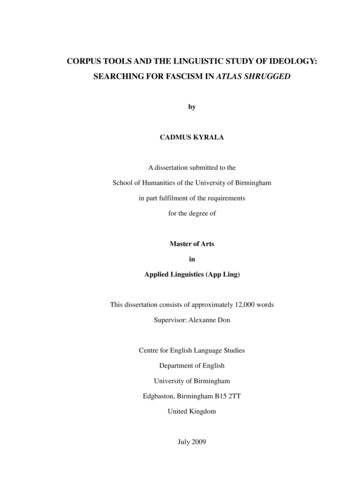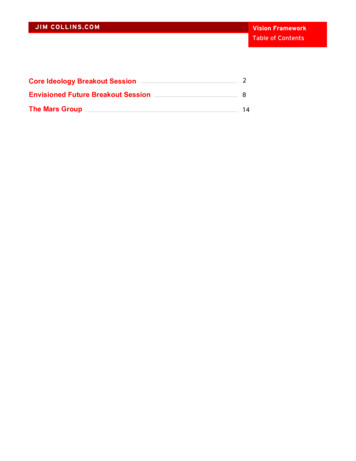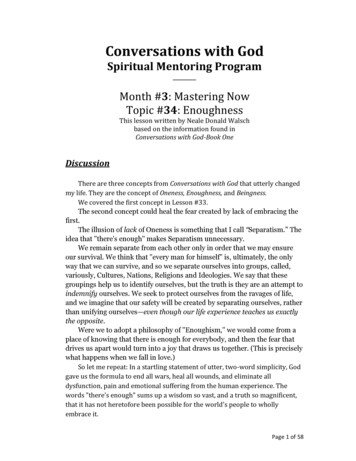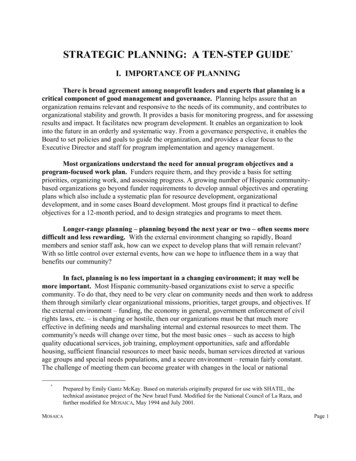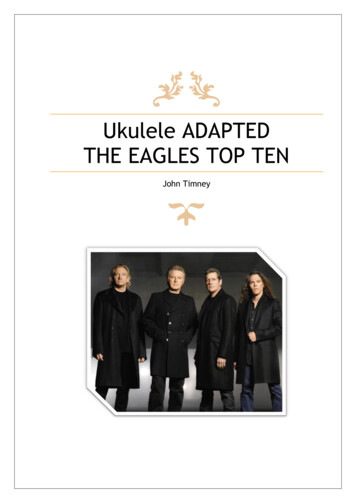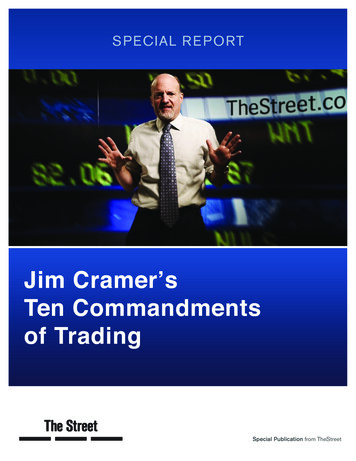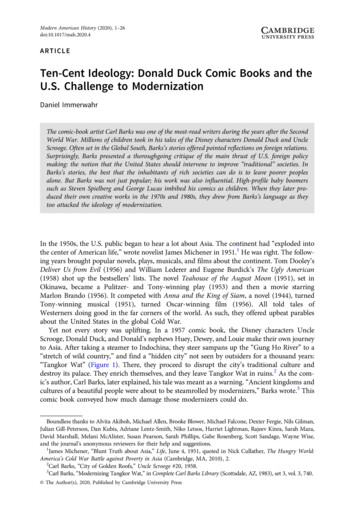
Transcription
Modern American History (2020), 1–26doi:10.1017/mah.2020.4ART ICLETen-Cent Ideology: Donald Duck Comic Books and theU.S. Challenge to ModernizationDaniel ImmerwahrThe comic-book artist Carl Barks was one of the most-read writers during the years after the SecondWorld War. Millions of children took in his tales of the Disney characters Donald Duck and UncleScrooge. Often set in the Global South, Barks’s stories offered pointed reflections on foreign relations.Surprisingly, Barks presented a thoroughgoing critique of the main thrust of U.S. foreign policymaking: the notion that the United States should intervene to improve “traditional” societies. InBarks’s stories, the best that the inhabitants of rich societies can do is to leave poorer peoplesalone. But Barks was not just popular; his work was also influential. High-profile baby boomerssuch as Steven Spielberg and George Lucas imbibed his comics as children. When they later produced their own creative works in the 1970s and 1980s, they drew from Barks’s language as theytoo attacked the ideology of modernization.In the 1950s, the U.S. public began to hear a lot about Asia. The continent had “exploded intothe center of American life,” wrote novelist James Michener in 1951.1 He was right. The following years brought popular novels, plays, musicals, and films about the continent. Tom Dooley’sDeliver Us from Evil (1956) and William Lederer and Eugene Burdick’s The Ugly American(1958) shot up the bestsellers’ lists. The novel Teahouse of the August Moon (1951), set inOkinawa, became a Pulitzer- and Tony-winning play (1953) and then a movie starringMarlon Brando (1956). It competed with Anna and the King of Siam, a novel (1944), turnedTony-winning musical (1951), turned Oscar-winning film (1956). All told tales ofWesterners doing good in the far corners of the world. As such, they offered upbeat parablesabout the United States in the global Cold War.Yet not every story was uplifting. In a 1957 comic book, the Disney characters UncleScrooge, Donald Duck, and Donald’s nephews Huey, Dewey, and Louie make their own journeyto Asia. After taking a steamer to Indochina, they steer sampans up the “Gung Ho River” to a“stretch of wild country,” and find a “hidden city” not seen by outsiders for a thousand years:“Tangkor Wat” (Figure 1). There, they proceed to disrupt the city’s traditional culture anddestroy its palace. They enrich themselves, and they leave Tangkor Wat in ruins.2 As the comic’s author, Carl Barks, later explained, his tale was meant as a warning. “Ancient kingdoms andcultures of a beautiful people were about to be steamrolled by modernizers,” Barks wrote.3 Thiscomic book conveyed how much damage those modernizers could do.Boundless thanks to Alvita Akiboh, Michael Allen, Brooke Blower, Michael Falcone, Dexter Fergie, Nils Gilman,Julian Gill-Peterson, Dan Kubis, Adriane Lentz-Smith, Niko Letsos, Harriet Lightman, Rajeev Kinra, Sarah Maza,David Marshall, Melani McAlister, Susan Pearson, Sarah Phillips, Gabe Rosenberg, Scott Sandage, Wayne Wise,and the journal’s anonymous reviewers for their help and suggestions.1James Michener, “Blunt Truth about Asia,” Life, June 4, 1951, quoted in Nick Cullather, The Hungry World:America’s Cold War Battle against Poverty in Asia (Cambridge, MA, 2010), 2.2Carl Barks, “City of Golden Roofs,” Uncle Scrooge #20, 1958.3Carl Barks, “Modernizing Tangkor Wat,” in Complete Carl Barks Library (Scottsdale, AZ, 1983), set 3, vol. 3, 740. The Author(s), 2020. Published by Cambridge University Press
2Daniel ImmerwahrFigure 1. The first glimpse of Tangkor Wat (Carl Barks, “City of Golden Roofs,” Uncle Scrooge #20, 1958).It might be tempting to dismiss Barks’s comic, which directly challenged core tenets of midcentury foreign policy making, as an anomaly. But Barks was the single most-read comicsauthor of the period—and one of the country’s most-read authors in any genre. Nor was foreign relations a side issue for him. He engaged the topic constantly; the Tangkor Wat story wasjust one item within a large corpus of extremely popular antimodernization tales that Barkspublished. A generation of young readers—the baby boomers—thus grew up regularly readingcomics that rejected the intellectual foundation of their own country’s official worldview.What is more, there is reason to think that Barks left a mark on his readers. It is, of course,always hard to know what people made of the texts they read, and it is even harder to knowwhat young people made of them. Yet there are peculiar features of the Barks corpus thathelp answer these questions. By following Barks’s distinctive tropes into cultural texts producedby adult boomers such as Steven Spielberg and George Lucas, we can distinguish the imprintthat Barks’s stories of Uncle Scrooge and Donald Duck made. For not only did Spielberg andLucas draw on Barks heavily in their films, particularly the Indiana Jones series, they also challenged the ideology of modernization in much the same terms he had. Moreover, theirBarks-influenced films proved wildly popular. What this suggests is that Barks mattered.Through his comic books, he had offered his young readers scripts for a different understanding of U.S. foreign relations. When those young readers grew up, those scripts prove useful as,in the wake of the Vietnam War, they confronted their country’s official worldview head-on.At the core of that worldview—the ideology of modernization—was an understanding of howscience, technology, industry, and their associated sociological transformations had carriedcountries like the United States into the vanguard of modernity. But it had an important political corollary. As a leading “modern” country, the United States could help “traditional” countries through their own process of modernization. That process, champions of modernizationpromised, would be beneficial, strategically desirable (so long as modernization did not take acommunist form), and, with time, inevitable.4The ideology of modernization, dominant in official circles from at least World War IIthrough the 1970s, played out on multiple levels. On the theoretical plane, social scientists4The historiography is vast and growing. A recent review of the literature is Joseph Hodge’s two-part series,“Writing the History of Development (Part 1: The First Wave),” Humanity: An International Journal of HumanRights, Humanitarianism and Development 6, no. 3 (2015): 429–63 and in Humanity: An International Journalof Human Rights, Humanitarianism and Development 7, no. 1 (2016): 125–174. A prize-winning book representingthe cutting edge of scholarship on modernization is Nathan J. Citino, Envisioning the Arab Future: Modernizationin U.S.–Arab Relations, 1945–1967 (Cambridge, UK, 2017).
Modern American History3converged on modernization theory, which Nils Gilman has described as the “highest floweringof American intellectual life” because it incorporated and integrated “many of the postwar period’s dominant ideas about society, politics, and economics.”5 At the level of practice, policymakers had modernization in mind when they staged their various interventions in theThird World (or, as it is often called outside of a Cold War context, the Global South).Christina Klein, meanwhile, has shown how the ideology of modernization “extended beyondthe realms of the political elite and suffused contemporary popular culture,” informing movies,popular fiction, and theater.6A sense of this multifaceted modernization campaign can be got from examining the placeof Thailand (called Siam until 1939) in U.S. arts and letters. Presbyterian missionary KennethLandon offered one of the most influential accounts of the country, an academic study titledSiam in Transition (1939), which argued that Siam was “adjusting to a technologicalworld.”7 Landon went on to work for the State Department and National Secretary Council,where he helped oversee hundreds of millions of dollars of U.S. foreign aid to Thailand tohelp it make that adjustment. In that period, Landon was the United States’s leadingThailand expert and “the single person most responsible for the postwar alliance betweenthe United States and Thailand.”8While Kenneth Landon scaled the commanding heights in Washington, his wife and fellowmissionary, Margaret Landon, acquired a different sort of influence. She wrote an enormouslysuccessful novel, Anna and the King of Siam (1944). The novel describes the arrival in the nineteenth century of the British Anna Leonowens at the Siamese court, where she becomes governess to King Mongkut’s children. Anna is a reformer, “someone who could fight withknowledge in the corner of the world where she found herself.” The king, who “has onefoot in the modern world of civilization and science,” accepts her influence.9The novel and its gospel of modernization proved not only popular but enduring. Two yearsafter publication, it was made into a film starring Rex Harrison. Then, in 1951, it became aTony-winning musical, The King and I, starring Yul Brynner as the king. Brynner also starredin the 1956 Oscar-winning film of the musical. In it, the king seeks to make Siam a “modern,very scientific country.” He sings about the intellectual upheavals involved in learning, forinstance, that the Earth is a ball suspended in space rather than a land lying on the back ofa turtle. Yet the king is undaunted, and the musical concludes with his embrace of modernizingreforms.Christina Klein has identified The King and I, in its various incarnations, as a widely influential text.10 One mark of its influence is that Barks’s story about Tangkor Wat took the film asits inspiration. When the ducks arrive, they encounter a traditional monarchy whose king lookslike Yul Brynner. But there the resemblance ends. The ducks do not come to Tangkor Wat asteachers, as Anna did. In Barks’s version, they come as salesmen, selling miniature tape recorders, and they are met with alarm (“Danger! Danger!” are the first words uttered by an inhabitant of Tangkor Wat). The king shows no interest in science. Instead, he bemoans how the tape5Nils Gilman, “Modernization Theory: The Highest Stage of American Intellectual History,” in Staging Growth:Modernization, Development, and the Global Cold War, eds. David C. Engerman et al. (Amherst, MA, 2003), 47–80, here 55.6Christina Klein, Cold War Orientalism: Asia in the Middlebrow Imagination, 1945–1961 (Berkeley, CA, 2003),191. Another key study of mass culture and U.S. foreign relations is Melani McAlister, Epic Encounters: Culture,Media, and U.S. Interests in the Middle East since 1945 (Berkeley, CA, 2001).7Kenneth Perry Landon, Siam in Transition: A Brief Survey of Cultural Trends in the Five Years Since theRevolution of 1932 (Chicago, 1939); David A. Hollinger tells the story of the Landons in Protestants Abroad:How Missionaries Tried to Change the World but Changed America (Princeton, NJ, 2017), ch. 8.8Hollinger, Protestants Abroad, 188.9Margaret Landon, Anna and the King of Siam (New York, 1944), 82, 49.10Klein, Cold War Orientalism, ch. 5.
4Daniel ImmerwahrFigure 2. Modernization by duck in the Disney rendition of The King and I, with Scrooge McDuck facing off against a YulBrynner lookalike (Barks, “Golden Roofs”).recorders have driven his once-loyal subjects “wild” and led them to abandon their duties.Seeing this, Scrooge cunningly encourages the unruly music fans to take up residence in thepalace, where they create an unbearable din. Then, in exchange for driving them out, he tricksthe king into allowing him to strip gold off the palace roof (Figure 2).11The story ends well for the ducks but horribly for Tangkor Wat. The courtly culture—whichBarks depicted with great sympathy—has been deranged, the royal treasury has been drained,and the palace roof has been melted down. Years later, Barks explained his intent in a shortessay titled “Modernizing Tangkor Wat.” His story, he explained, had captured the “ominousdrumbeat of doom” that had been sounding in Asia.12 It was a warning about the consequencesof U.S. intervention for the traditional cultures there. This was not a tale of a king bravely leading his country into the future, in other words. This was a story about a catastrophe.If a monograph, a novel, two films, and a musical all told a story one way, how significant is itthat a single story in a comic book told it another? In other words, how meaningful is it, really,that Barks’s comic diverged from the party line concerning modernization? It may not seemmeaningful, given comics’ place at the bottom of the cultural hierarchy. Yet if comics were lowbrow, they were not marginal. Children nourished themselves on a steady diet of them, available at the newsstand for ten cents. Adults read comics, too—a 1945 survey counted 41 percentof men and 28 percent of women between the ages of 18 and 30 as comic book readers.13 For abrief moment, roughly from the end of the Second World War until their displacement by television in the late 1950s, comic books became one of the most important vehicles for the transmission of culture.At the center of the comics boom stood a single intensely prolific creator, Carl Barks, whowrote, penciled, inked, and lettered the Donald Duck comic books published by Dell. Sincecomics featuring Disney characters were presented as the personal work of Walt Disney,Barks toiled in obscurity for nearly his whole career. Sharp-eyed fans, recognizing his superiorcraft and distinctive style, knew him only as “the Good Duck Artist.”14 Yet from his home inthe San Jacinto area near Los Angeles, where he handled every aspect of production short ofcoloring and printing, Barks created an astonishing corpus. He turned Donald Duck, anBarks, “Golden Roofs.”Barks, “Modernizing Tangkor Wat,” 740.13Bradford W. Wright, Comic Book Nation: The Transformation of Youth Culture in America (Baltimore, 2001),57.14Ron Goulart, Great American Comic Books (Lincolnwood, IL, 2001), 325.1112
Modern American History5Figure 3. Uncle Scrooge, swimming in his money bin, in Carl Barks, “Only a Poor Old Man” Four Color #386, 1952.irascible film character known mainly for his sputtering incoherence, into a calmer and morearticulate everyduck. Month after month, starting in 1943, he sent Donald on adventures in thecompany of his nephews Huey, Dewey, and Louie, adventures that often deposited the ducks infar-flung locales. Over the course of the more than 500 full-length stories he wrote, Barks builtout Donald’s world, adding characters, most notably the fantastically rich Uncle ScroogeMcDuck, whose incessant search for wealth occasioned still more trips to the GlobalSouth (Figure 3). Scrooge soon surpassed Donald as a driver of newsstand sales.Those sales, it must be said, were staggering. Walt Disney’s Comics and Stories, the principalthough not sole vehicle for the ducks’ adventures, sold more than three million copies per issueat its peak in 1953.15 That was more than Superman, more than any other comic.16 It was significantly more, in fact, than the circulations of the New Yorker (0.4 million), Esquire (0.7 million), Newsweek (1 million), Time (1.9 million), or National Geographic (2.2 million). Only ahandful of periodicals outsold it, among them the Saturday Evening Post (4.6 million) andReader’s Digest (10.2 million).17 What is more, Walt Disney’s Comics and Stories was joinedby another duck title, Uncle Scrooge, which sold in comparable numbers, plus a torrent of oneshot titles in Dell’s Four Color anthology series and various promotional issues (Barks producedcomics given away in cereal boxes, at shoe stores, and at tire dealerships).1815According to George Sherman at Disney Studio, Walt Disney’s Comics and Stories sold 3,039,000 copies of itsSeptember 1953 issue. Reported in Donald Ault, ed., Carl Barks: Conversations (Jackson, MS, 2003), xvii. Salesdropped rapidly in the early 1960s, as chronicled in Michael Barrier, Funnybooks: The Improbable Glories of theBest American Comic Books (Oakland, CA, 2015), 297, 336, 338.16Thomas Andrae, Carl Barks and the Disney Comic Book: Unmasking the Myth of Modernity (Jackson, MS,2006), 6.17Circulation figures, all from 1955, in Theodore Preston, Magazines in the Twentieth Century (Urbana, 1956),82, 241, 262. Preston does not offer figures for comics.18Paul Ciotti, “Writing to Please Myself: An Interview with Carl Barks,” in Ault, Conversations, 26.
6Daniel ImmerwahrComics also had important properties that other periodicals lacked. Not only did the duckcomics sell well, they—like other comics—had extraordinary pass-along rates, with probablytwo to four readers per issue.19 Those readers also revisited the comics frequently and insome cases obsessively, which cannot be as easily claimed for Newsweek or the SaturdayEvening Post. Another distinctive feature is that the lead story in Walt Disney’s Comics andStories was almost always by the same author. It is thus not at all an exaggeration to crownthat anonymous author, whom we now know to be Carl Barks, the most-read magazine writerof the 1950s.20Carl Barks was an unusual breed of literary lion. He grew up on what he called a “little wheatranch” in southern Oregon, dropped out of school after the eighth grade, and had scant engagement with the high- or even middlebrow culture of his time. Among his few influences he citedPrince Valiant, Tarzan, and the pulp novels of Zane Grey, though he confessed to skipping theslow bits.21 He supported himself as a logger and a member of a riveting gang until he foundwork drawing cartoons for the risqué Calgary Eye-Opener. He then moved to the Disney studioin the 1930s, where he worked as an animator (including, briefly, on Bambi), but he quit animation for comic books in the 1940s, where he found his calling. His career in comics mapsneatly onto the chronology of high U.S. global supremacy: the first story he wrote and drewappeared in 1943, the last in 1967.Despite his work’s tremendous popularity, Barks lived in solitude. He alone handled thebulk of the production on his stories, venturing into the “big city” (Los Angeles) for “nomore than a few minutes once or twice a month” to drop off his work, as he put it.22 His publisher kept his fan mail from him (they “probably feared I would ask for a raise”), so that in hisfirst seventeen years on the job he received only three letters.23 His social world was furtherconfined by his partial deafness and, early in his career, by his entrapment in an abusive marriage with an alcoholic wife.24 The result was profound isolation. Barks had a counterpart in thefunny animal–drawing business, Floyd Gottfredson, who drew the Mickey Mouse stories thatappeared in the same comic books as Barks’s Donald Duck stories. Yet though Barks admired19Pass-along rates are hard to measure. Barks estimated that “at least twice” as many people read his comics asbought them. Ciotti, “Writing to Please Myself,” 26. Norbert Muhlen estimated three to four readers for everycomic book. Norbert Muhlen, “Comic Books and Other Horrors,” Commentary 8, January 1949, 80–7, here 81.20Though Carl Barks is not a widely recognized figure in cultural history, there is a substantial scholarly literatureabout him. The best-known treatment is Ariel Dorfman and Armand Mattelart, How to Read Donald Duck:Imperialist Ideology in the Disney Comic, trans. David Kunzle (1971; New York, 1991), a playful critique of theDisney comics marketed in Chile. Dorfman and Mattelart were not aware of Carl Barks’s identity, though, andtreated all Disney comics (many Barks-produced, others not) as the work of a single corporate author. Threebooks—Michael Barrier’s Carl Barks and the Art of the Comic Book (New York, 1981), Andrae’s Carl Barks,and Barrier’s Funnybooks—are excellent guides. Though no archive holds Barks’s papers, fans interviewed Barksrepeatedly over his long life. Those interviews, many of which ran originally in fanzines, have been collected inDonald Ault’s indispensable anthology, Carl Barks: Conversations, which should be considered alongsideBarrier’s and Andrae’s books as a pillar of Barks scholarship. Two collected works of Carl Barks, the thirty-volumeComplete Carl Barks Library, published by Another Rainbow in 1983, and the still-being-released Complete CarlBarks Disney Library, published by Fantagraphics starting in 2011, contain useful critical essays. Much of thisscholarship, in distinction from the present article, seeks more to understand Barks’s craft—Andrae describeshis goal as establishing the “depth and complexity” of Barks’s corpus—than to make broader arguments about cultural history (17).21Edward Summer, “Of Ducks and Men: Carl Barks Interviewed,” in Ault, Conversations, 89; Edward Summer,“Fortune Favors the Bold: An Interview with Carl Barks,” in Ault, Conversations, 125.22Malcom Willits, Don Thompson, and Maggie Thompson, “The Duck Man,” in Ault, Conversations, 8.23Donald Ault, Bruce Hamilton, John Ronan, and Nicky Wright, “Living the Stories: The Carl Barks Genius,” inAult, Conversations, 218.24For Barks’s reflections on his deafness and abusive relationship, see Barrier, Funnybooks, 142 and 263–4,respectively.
Modern American History7Gottfredson and though both lived in California, it was not until the 1980s—nearly twodecades after retiring—that Barks even met Gottfredson.25Barks was, in his own telling, “strictly a hack,” paid by the page, and paid poorly enough tofeel significant economic strain for his whole career.26 As was frequent in the industry, intellectual property rights went to Disney, not Barks—including for the endlessly lucrative character Uncle Scrooge. Thus, Barks was not paid royalties, he was not paid when his comics werereprinted or translated, and he was not paid in the 1980s when his characters and storiesbecame the basis of a popular animated television show, DuckTales. Barks did not even receivecopies of his own comics—he had to buy them from the newsstand.27 He had been, as he putlater it to a fan, “a sharecropper on old Marse Disney’s animal farm.”28After Barks’s retirement, an interviewer noted the central and—some might say—cruel ironyof his career: Barks had been a piece-rate worker who had never saved enough for a vacation oreven left the country, yet he had spent his working life spinning out hundreds of tales of travel,leisure, and prodigious wealth accumulation. “Oh heavens, yes,” Barks replied. “That’s too trueto be funny.”29 And yet, from his lonely and not particularly luxurious perch in SouthernCalifornia, Barks patched into the minds of millions of children. It mattered that he did thisthrough the new genre of the comic book. Unlike comic strips, which appeared in all-agesnewspapers, comic books were sold directly to children, at child-attainable prices.The rapid emergence of comic books had caught the country by surprise. The first comicbooks appeared in the 1930s, and by 1945 they outsold regular books two to one.30 It didnot take long for fears of this new medium to arise, especially given the growing readershipfor lurid crime and horror comics. “The time has come to legislate these books off the newsstands and out of candy stores,” the noted child psychologist Fredric Wertham argued.31 Therewere comic book burnings, boycotts, and censorship campaigns.32 Eventually, the anti-comicsbacklash grew large enough to force the major publishers to self-censor through a morals codein 1954—the comic-book analog to film’s Hays Code. Much of the comics market quicklywithered.Much, that is, except for the funny animal comic books. These were, Wertham allowed, the“mainstay of the ‘good’ comic books,” the least troubling of the newsstand offerings.33 “Funny,gay animals,” wrote the author of one of the first book-length studies of comics, “who couldpossibly object to that?”34 Not many, it seemed. The all-important Cincinnati Committee onthe Evaluation of Comic Books registered objections to Superboy, Wonder Woman, JohnWayne, G. I. Joe, and Tarzan, but not the Barks comics.35 Barks’s publisher, Dell, did notLeonardo Gori and Francesca Stajano, “Carl Barks: On Floyd Gottfredson,” in Ault, Conversations, 202.Donald Ault, “Carl Barks, Telling It Like It Is,” in Ault, Conversations, 46.27Ibid., 47.28Andrae, Carl Barks, 98.29J. Michael Barrier, “Carl Barks and His Ducks,” in Ault, Conversations, 74.30Muhlen, “Comic Books,” 81.31Fredric Wertham, quoted in Judith Crist, “Horror in the Nursery,” Collier’s, Mar. 27, 1948, 22.32Bart Beaty, Fredric Wertham and the Critique of Mass Culture (Jackson, MS, 2005), 116. See also David Hajdu,The Ten-Cent Plague: The Great Comic-Book Scare and How It Changed America (New York, 2008).33Fredric Wertham, Seduction of the Innocent (New York, 1954), 307. Wertham nevertheless worried that eventhese contained themes of violence.34Coulton Waugh, The Comics (New York, 1947), 166.35Jesse L. Murrell, “Are Comics Better or Worse?” Parents’ Magazine, Aug. 1955, 48–50. Despite their commanding sales figures, funny animal comics are not a topic of central interest in comics studies. Attention hasflowed more regularly to superhero and horror comics. For instance, Bradford Wright, in his important historyof comic books, entirely excludes funny animal comics—comics which, it should be repeated, outsold the superherocomics—on the dubious grounds that they “possess a certain timeless and unchanging appeal for young childrenthat makes them relatively unhelpful for the purposes of a cultural history.” Wright, Comic Book Nation, xviii.Funny animal comics also have little place in other surveys of comics history such as William W. Savage Jr.,Comic Books and America, 1945–1954 (Norman, OK, 1990); Gerald Jones, Men of Tomorrow: Geeks, Gangsters,2526
8Daniel Immerwahreven submit its books to the industry’s censorship code. Instead, it boasted in its “pledge toparents” that its own more stringent internal code “eliminates entirely, rather than regulates,objectionable material.”36 Taking this high road appears to have worked. When other comicbooks failed (Captain America ceased publication in 1949), Dell’s kept going. By 1957, afterthe dust settled on the censorship controversy, its titles accounted for a full one-third of allU.S. sales.37This assiduously cultivated aura of innocence helped abroad, too. It allowed Barks’s comicsto cross borders, including into countries, such as postwar West Germany and Japan, that weresubjecting themselves to intense cultural scrutiny and were thus extremely cautious about whatchildren read.38 Through international sales of Barks’s work, his creation Uncle Scroogebecame a recognized figure worldwide. Interestingly, as Jean-Paul Gabilliet has observed,Scrooge is “the only character of an American comic to have acquired a global celebrity withoutrelying on cinema or television.”39One Japanese comic artist, Osamu Tezuka, remembered how U.S. comics were “imported bythe bushelful” into postwar Japan and “had a tremendous impact” there.40 The Disney comicsin particular drew Tezuka’s eye. He adapted Barks’s style—cartoonishly rendered main characters with enormous eyes and small bodies overlaid onto more realistically drawn backgrounds—to his own work, including the popular comic Astro Boy.41 Tezuka’s art in turn sparked theexplosion of manga, the comic book form that dominated Japanese culture after the SecondWorld War and gave rise to anime.After television sapped his domestic audience, Barks remained prominent abroad, andremains so today. In the 1970s, the Los Angeles Times reported that Disney comics sold 250million copies a year globally, a figure that Barks affirmed (some were new stories, manywere reprints of Barks’s work).42 When the Argentinian writer Ariel Dorfman sought toaddress U.S. cultural imperialism, he chose as his subject the duck comics. His How to ReadDonald Duck, written with Belgian sociologist Armand Mattelart, noted how ubiquitous theyhad become in Chile, where Dorfman and Mattelart then lived. Donald Duck, Dorfmanwrote, was the “most imperialist of creatures.”43and the Birth of the Comic Book (New York, 2004); and Hajdu, Ten-Cent Plague—none of these mentions Barks.The overview that takes funny animal comics and Barks seriously is Jean-Paul Gabilliet, Of Comics and Men: ACultural History of Comic Books, trans. Bart Beaty and Nick Nguyen (2005; Jackson, MS, 2010).36Walt Disney’s Comics and Stories #180, 1955, inside cover.37Amy Kiste Nyberg, Seal of Approval: The History of the Comics Code (Jackson, MS, 1998), 116.38Ryan G. O’Neill, “An Exploration of Comics and Architecture in Post-War Germany and the United States”(Ph.D. diss., University of Minnesota, 2016), 92–4. Pierre Assouline describes how censorship kept manynon-Disney U.S. comics out of France in Hergé: The Man Who Created Tintin, trans. Charles Ruas (New York,2009), 164–6. Background is in John A. Lent, ed., Pulp Demons: International Dimensions of the PostwarAnti-Comics Campaign (London, 1999).39Gabilliet, Of Comics and Men, 32.40Quoted in Paul Gravett, Manga: Sixty Years of Japanese Comics (New York, 2004), 28.41This is explored in “The Carl Barks/Osamu Tezuka Connection,” The Comics Cube, Jan. 7, 2016, amu-tezuka-connection.html (accessed Dec. 18, 2019).42Ciotti, “Writing to Please Myself,” in Ault, Conversations, 27.43Ariel Dorfman, Heading South, Looking North: A Bilingual Journey (New York, 1998), 74. Dorfman’s critiqueof the duck comics can be found in Dorfman and Mattelart, How to Read Donald Duck; Ariel Dorfman, TheEmpire’s Old Clothes: What the Lone Ranger, Babar, and Other Innocent Heroes Do to Our Minds (New York,1983); and Ariel Dorfman, “Get Rich, Young Man, or, Uncle Scrooge through the Looking Glass,” 1982, inOther Septembers, Many Americas: Selected Provocations, 1980-–2004 (London, 2004). Dorfman later partly disavowed How to Read Donald Duck, explaining that he had “exaggerated the villainy of the U.S. and the noblenessof Chile” an
comics that rejected the intellectual foundation of their own country’s official worldview. What is more, there is reason to think that Barks left a mark on his readers. It is, of course, always hard to know what peop
